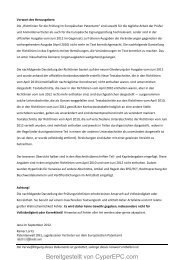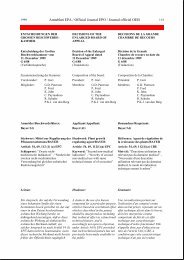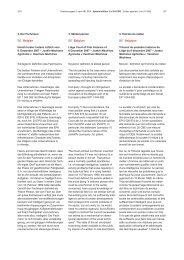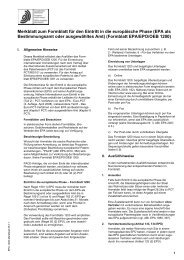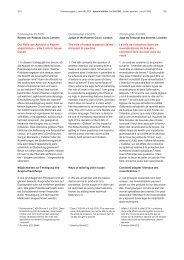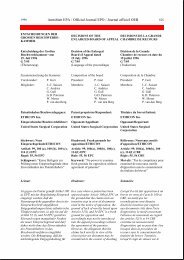Case Law from the Contracting States to the EPC 2004 ... - CyberEPC
Case Law from the Contracting States to the EPC 2004 ... - CyberEPC
Case Law from the Contracting States to the EPC 2004 ... - CyberEPC
You also want an ePaper? Increase the reach of your titles
YUMPU automatically turns print PDFs into web optimized ePapers that Google loves.
62 Sonderausgabe 3 zum ABl. EPA Special edition 3 of OJ EPO Edition spéciale 3 du JO OEB 2011<br />
rische Tätigkeit aufweisen, um auch die<br />
technischen Aufgaben zu lösen, die in<br />
der Übertragung selbst impliziert sind.<br />
impliquer une activité inventive visant à<br />
surmonter les problèmes techniques<br />
implicites dans la transposition proprement<br />
dite.<br />
NL Niederlande<br />
Bezirksgericht Den Haag<br />
(Rb. te 's-Gravenhage) vom<br />
9. Dezember 2009 – Intervet v. Merial<br />
Schlagwort: erfinderische Tätigkeit –<br />
Vorveröffentlichung<br />
Die von Merial gehaltenen Streitpatente<br />
(EP 1 281 760, EP 1 386 617) betrafen<br />
die Isolierung eines neuen Virustyps,<br />
der für das Ausbrechen des (am Prioritätstag<br />
im Jahr 1997 bereits bekannten)<br />
sogenannten Postweaning Multisystemic<br />
Wasting Syndroms (PMWS) ("seuchenhaftes<br />
Kümmern nach dem Absetzen")<br />
bei Schweinen verantwortlich ist. Intervet<br />
griff das Patent mit Verweis auf eine Vorveröffentlichung<br />
an, in der angeblich die<br />
gleichen Erkenntnisse offenbart waren.<br />
Das Gericht erkannte das angeführte<br />
Dokument als Stand der Technik an<br />
und stellte fest, dass das Isolieren<br />
dieses neuen Virustyps keine erfinderische<br />
Tätigkeit aufweise. Auch wenn<br />
aus der Vorveröffentlichung nicht eindeutig<br />
hervorgehe, was einen neuen<br />
Virustyp ausmache, werde der Fachmann<br />
angeregt, seine Forschung auf<br />
das Isolieren neuer Varianten auszurichten,<br />
anstatt sich auf die bekannten<br />
Varianten zu konzentrieren. Auch die<br />
Auffassung des Patentinhabers, dass<br />
das Isolieren eines neuen Virus als<br />
solches erfinderisch sei, konnte das<br />
Gericht nicht teilen. Zur Stützung seines<br />
Arguments hatte der Patentinhaber auf<br />
T 1231/01 verwiesen, wo es um eine<br />
vergleichbare Erfindung mit Prioritätstag<br />
im Jahr 1992 gegangen war. In dieser<br />
Entscheidung hatte die Beschwerdekammer<br />
festgestellt, dass das Isolieren<br />
eines spezifischen Virusstamms, der als<br />
Bestandteil eines Impfs<strong>to</strong>ffs Schweine<br />
vor dem porcinen reproduktiven und<br />
respira<strong>to</strong>rischen Syndrom schützen<br />
sollte, eine erfinderische Tätigkeit war.<br />
Nach Auffassung des Gerichts ist aus<br />
dieser Entscheidung jedoch nicht abzuleiten,<br />
dass das Isolieren eines Virus<br />
in jedem Fall auf einer erfinderischen<br />
NL Ne<strong>the</strong>rlands<br />
The Hague District Court<br />
(Rb. te 's-Gravenhage) of<br />
9 December 2009 – Intervet v Merial<br />
Keyword: inventive step – prior-art<br />
document<br />
Merial's European patents<br />
(EP 1 281 760, EP 1 386 617) in <strong>the</strong><br />
case at issue concerned <strong>the</strong> isolation<br />
of a new type of virus responsible for<br />
<strong>the</strong> breakout of <strong>the</strong> (by <strong>the</strong> 1997 priority<br />
date already known) weaning disease<br />
(Postweaning Multisystemic Wasting<br />
Syndrome, PMWS) in pigs. Intervet<br />
challenged <strong>the</strong> validity of <strong>the</strong> invention<br />
by reference <strong>to</strong> a prior-art document<br />
which allegedly disclosed <strong>the</strong> same<br />
insight.<br />
Recognising <strong>the</strong> cited document as part<br />
of <strong>the</strong> state of <strong>the</strong> art, <strong>the</strong> Court held that<br />
<strong>the</strong> isolation of that new virus type lacked<br />
an inventive step. Although <strong>the</strong> requirements<br />
for <strong>the</strong> qualification for a new virus<br />
type as set out in <strong>the</strong> prior-art document<br />
were not clear-cut, <strong>the</strong> skilled person<br />
would feel stimulated <strong>to</strong> aim his research<br />
at <strong>the</strong> isolation of new variants instead of<br />
<strong>the</strong> known ones. Moreover, <strong>the</strong> Court<br />
could not share <strong>the</strong> view of <strong>the</strong> patentee<br />
that <strong>the</strong> isolation of a new virus as such<br />
was inventive. In support of its argument,<br />
<strong>the</strong> patentee relied on T 1231/01, which<br />
concerned a similar invention with a<br />
1992 priority date. In that decision, <strong>the</strong><br />
Board of Appeal had held <strong>the</strong> isolation of<br />
a specific virus strain as a component of<br />
a vaccine <strong>to</strong> protect pigs against <strong>the</strong><br />
reproductive and respira<strong>to</strong>ry syndrome<br />
<strong>to</strong> be inventive.<br />
According <strong>to</strong> <strong>the</strong> Court, however, it could<br />
not be deduced <strong>from</strong> this decision that<br />
<strong>the</strong> isolation of a virus was unreservedly<br />
inventive. Ra<strong>the</strong>r, <strong>the</strong> assessment<br />
NL Pays-Bas<br />
Tribunal de grande instance de<br />
La Haye (Rb. te 's-Gravenhage) du<br />
9 décembre 2009 – Intervet c. Merial<br />
Mot-clé : activité inventive – antériorité<br />
Les brevets européens de Merial<br />
(EP 1 281 760, EP 1 386 617) mis en<br />
cause dans cette affaire portent sur<br />
l'isolement d'un nouveau type de virus<br />
responsable du développement du<br />
syndrome de dépérissement généralisé<br />
de post-sevrage chez les porcs (en<br />
anglais PMWS, déjà connu jusqu'à la<br />
date de priorité en 1997). Intervet a mis<br />
en cause la validité de l'invention en se<br />
référant à un document de l'état de la<br />
technique qui était supposé divulguer<br />
les mêmes informations.<br />
Reconnaissant que le document cité<br />
faisait partie de l'état de la technique, le<br />
Tribunal a considéré que l'isolement de<br />
ce nouveau type de virus ne présentait<br />
pas d'activité inventive. Même si les<br />
exigences visant à qualifier un nouveau<br />
type de virus tel qu'exposé dans le<br />
document de l'art antérieur ne sont pas<br />
clairement définies, l'homme du métier<br />
se sent incité à orienter ses recherches<br />
vers l'isolement de nouvelles variantes<br />
au lieu de celles déjà connues. En outre,<br />
le Tribunal n'a pu se rallier à l'avis du<br />
titulaire du brevet selon lequel l'isolement<br />
d'un nouveau virus en tant que tel a un<br />
caractère inventif. Pour appuyer son<br />
argument, le titulaire du brevet s'est<br />
fondé sur la décision T 1231/01 concernant<br />
une invention similaire, avec une<br />
date de priorité en 1992. Dans cette<br />
décision, la chambre de recours avait<br />
considéré comme inventif l'isolement<br />
d'une chaîne de virus spécifique en tant<br />
qu'élément de vaccin destiné à protéger<br />
les porcs contre le syndrome reproducteur<br />
et respira<strong>to</strong>ire.<br />
Selon le Tribunal, cependant, il n'est pas<br />
possible d'en conclure que l'isolement<br />
d'un virus revêt systématiquement et<br />
sans réserve un caractère inventif. Cette



